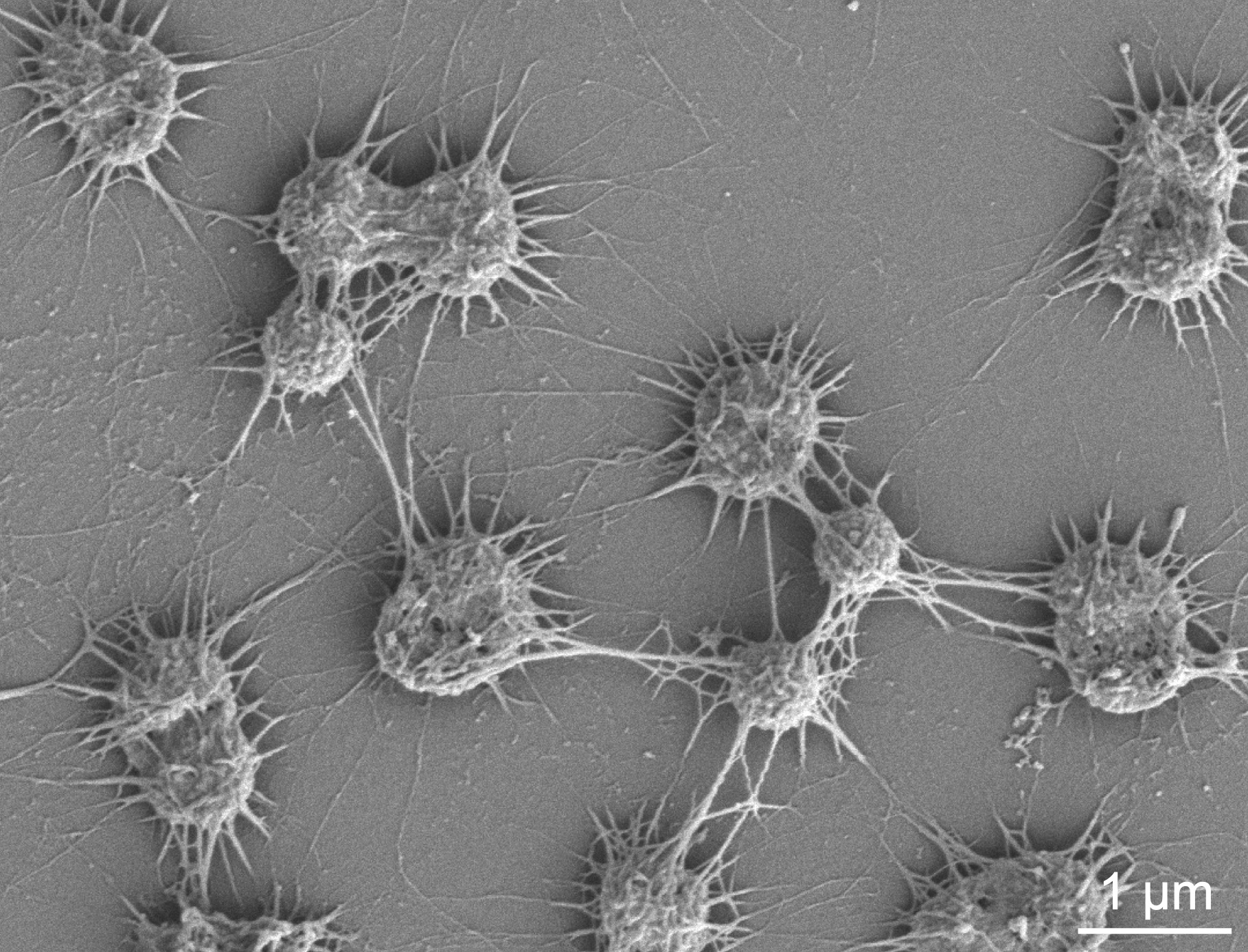Meta-omics datasets show that CRISPR-Cas systems determine mutualism or parasitism between some archaeal hosts and their hitchhikers.

Altiarchaea, a microbe in the same genus as the host studied here. (Image used with permission from Indra Banas and Alexander Probst)
The Science
Within the archaeal domain, there is a group of tiny hitchhikers. These organisms are abundant and yet exceptionally small, with mini genomes to match. As a result, they cannot process all of the chemicals they need to survive. To fill in their nutrient gaps, they must latch onto a larger host — often, a fellow archaeal microbe. Understanding how these hosts and hitchhikers coexist is key for understanding their impact on wider ecosystems, but these symbiotic interactions are difficult to study in the lab. Metagenomics provides new views of these relationships. Recently, researchers used population genomics to find that while archaeal hitchhikers may often act as parasites, in other cases, they likely help their hosts.
The Impact
Meters below the Earth’s surface, within the crust, there is a vast ecosystem connected to the global carbon cycle. Archaea are key players in this deep biosphere. They have adapted to acquire carbon efficiently and convert it to usable organic compounds. However, no microbe works alone. Archaea, bacteria, and viruses all operate in concert to form the foundation of this deep Earth ecosystem. For example, when certain viruses attack, their archaeal hosts release organic carbon. Understanding these complex symbioses between organisms feeds into a better understanding of nutrient cycling across the planet.
Summary
To understand more about how archaeal hosts and hitchhikers coexist, researchers studied the host Ca. Altiarchaeum and its hitchhiker Ca. Huberiarchaeum. Both organisms are part of the DPANN superphylum of Archaea. This pair is abundant in two subsurface ecosystems in very different parts of the world: Crystal Geyser, Utah, USA, and Horonobe Underground Research Laboratory, Hokkaido, Japan.
From samples of both environments, they used fluorescence in situ hybridization to confirm the microorganisms had a close relationship. Then, using metagenomes and metatranscriptomes generated by the U.S. Department of Energy (DOE) Joint Genome Institute (JGI), a DOE Office of Science User Facility located at Lawrence Berkeley National Laboratory (Berkeley Lab), as well as publicly available metagenomes, they analyzed both host and hitchhiker genomes for commonalities.
In host genomes, they found a huge variety of CRISPR-Cas systems. Generally, prokaryotes use CRISPR-Cas systems to recognize and remove invaders’ DNA from their own genomes. One of these systems, the CRISPR-Cas9 system, is a powerful tool in gene editing, but many other systems exist.
Investigating the CRISPR spacer systems of these two organisms suggested new possibilities beyond the current understanding that CRISPR-Cas systems target infectious agents like viruses and plasmids. First, Ca. Altiarchaeum had CRISPR-Cas systems targeting Ca. Huberiarchaeum. This shows that archaea may use CRISPR systems to protect against other, parasitic archaea. However, when Ca. Altiarchaeum harbored self-targeting CRISPR systems, metabolic modeling showed that Ca. Huberiarchaeum would help fill in metabolic weaknesses. In such cases, these DPANN hitchhikers likely form a mutualistic relationship with their hosts.
Contacts
BER Contact
Ramana Madupu, Ph.D.
Program Manager
Biological Systems Sciences Division
Office of Biological and Environmental Research
Office of Science
US Department of Energy
Ramana.Madupu@science.doe.gov
PI Contact
Alexander Probst
University of Duisburg-Essen, Essen, Germany
alexander.probst@uni-due.de
Funding
This research was supported in part by the Allen Distinguished Investigator Program, through The Paul G. Allen Frontiers Group, the National Science Foundation (MCB-1244557 to J.A.D.) and the Lawrence Berkeley National Laboratory’s Sustainable Systems Scientific Focus Area funded by the US Department of Energy (DE-AC02-05CH11231 to J.F.B.). The work (proposal doi: 10.46936/10.25585/60000800) conducted by the U.S. Department of Energy Joint Genome Institute (https://ror.org/04xm1d337), a DOE Office of Science User Facility, is supported by the Office of Science of the U.S. Department of Energy operated under Contract No. DE-AC02-05CH11231.
Publication
Esser, S.P., Rahlff, J., Zhao, W. et al. A predicted CRISPR-mediated symbiosis between uncultivated archaea. Nat Microbiol (2023). doi: 10.1038/s41564-023-01439-2
Related Links
- JGI Science Highlight: Plotting a Model for Virus-Host Warfare Deep Below Ground
- JGI Science Highlight: Mining Metagenomes for Cas Proteins
- JGI News Release: Tracking Microbial Diversity Through the Terrestrial Subsurface
- JGI Science Highlight: Metagenomics Leads to New CRISPR-Cas Systems